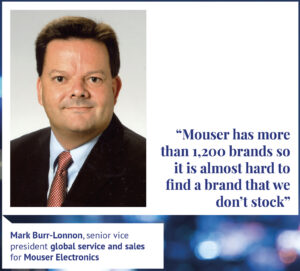
An increase in design engineering activity and tight supply of chips and other components is resulting in skyrocketing sales for high-service distributors.
High-service electronics distributors have weathered the coronavirus pandemic with some reporting a 50 per cent increase in sales during the first five months of 2021.
Most high-service distributors focus on design and sell small quantities of parts to engineers designing new products. Design activity has increased significantly in the first half of 2021. However, high-service distributors also report they are seeing strong sales from buyers at OEMs and electronics manufacturing services (EMS) providers who are looking for shortage components or parts needed for small production runs.
“OEM and EMS providers needing parts for shortages and short production runs have always been part of our business,” said Uma Pingali, business president for Newark. “But that business is now growing at a greater clip because of supply chain disruptions” caused by the pandemic, he said.
RS Components is also seeing increased business because of tight supply. “There is an opportunistic part of the market related to the surge of business,” said Chris Beeson, group senior vice president-electronics for RS Components. “Large OEMs in automotive have supply chains that are so fine-tuned, when there is any type of volatility in the markets, those supply chain programs get tested. Right now, some of them have obviously not fared well,” he said.
Buyers in automotive and other industries have been reaching out to small-volume, catalog distributors because they have available inventories of a wide breadth of parts including some of those that are in short supply.
“I’d be lying to say that allocations and long lead times have not helped our business,” said Mark Burr-Lonnon, senior vice president global service and sales for Mouser Electronics.
“They absolutely have.” He said Mouser has been increasing its inventory dramatically over the last 10 years.

Sales surpass 50 per cent
That strategy has proven to be advantageous to Mouser. So far this year through May Mouser’s sales to OEMs are up 51 per cent. EMS business has increased 47 per cent and its MRO business is up 40 per cent, said Burr-Lonnon. If sales continue at the same run rate Mouser’s sales will reach $3 billion in 2021, up from $2 billion, he said.
The scenario is similar for other high service distributors. Beeson said RS’s sales were up 50 per cent “in many areas of our products portfolio. Even when I look at a two-year comparison going back to 2019, we would still see the business cycle growing about 25 per cent,” he said. He added RS is also growing its customer count and is adding suppliers.
At Digi-Key sales through May were up 50 per cent, said Jim Ricciardelli, executive vice president of digital business for Digi-Key. The high-service distributor had recorded $3.1 billion in sales three years ago and finished 2020 just under $3 billion, he said.
“At the current run rate, we will go over $4 billion in revenue,” he said. “A lot of it has to do with tight supply. Because we have available inventory, a lot of OEMs and EMS companies are coming to us,” said Ricciardelli. “We have a deep selection of parts,” he said. “Any time an EMS provider or an OEM has high-mix, low-volume opportunity they know Digi-Key will have the stock available to sell.”
 Customer count is rising
Customer count is rising
Another reason for sales growth is an increase in customers using high-service distributors. “Right now, we are approaching 800,000 customers around the world. The number of customers grew 22 per cent last year,” said Ricciardelli. Engineers appreciate the wide breadth of products that Digi-Key offers, he said.
“An engineer does not want to go to a lot of different sites to buy different components,” said Ricciardelli. If an engineer needs to buy 100 components for an NPI project, he or she prefers a one-stop shop. “That’s where the breadth of product becomes important,” said Ricciardelli. “They can get the capacitors, the resistors, controllers and sensors all in one place in the quantities that they want,” he said.
Breadth of product is a differentiator for high-service distributors over large-volume distributors. “The number of stock keeping units (SKUs) for a high-service distributor is probably 15-20X the number of SKUs that are kept in inventory at any point compared to any other distributor,” said Pingali of Newark.
High-service distributors are continuing to try to build inventory by adding products from new component manufacturers or buying more from current suppliers. “Having breadth of inventory is “the big thing” for Mouser, “said Burr-Lonnon. “We spend a lot of time growing that breadth with all suppliers.” He said Mouser has more than $800 million of available inventory and about 25 per cent of its stock is new products, which are components that had been introduced within the last two years.
Niche brands added
He said Mouser has more than 1,200 brands “so it is almost hard to find a brand that we don’t stock.” He said because Mouser already carries most of the larger, well-known brands, it is now adding small “nichy” brands at a rate of about 10 per month.
Burr-Lonnon said Mouser needs to have that inventory because it services about 100,000 customers worldwide. Large volume distributors only have about 30,000 customers, he estimates.
Mouser as a high-service distributor has a broader customer base in terms of volume. “We are happy to deal with everybody from the guy who wants to buy one piece” to companies that want to buy larger volumes of parts, he said. “We don’t shoo anyone away.” Large volume distributors have a “huge amount of inventory on the big runners because they are trying to look after a limited number of customers,” said Burr-Lonnon.
Burr-Lonnon said besides breadth of inventory, Mouser also has 27 locations around the world which provide local service to customers, which is an integral part of Mouser’s high-service model. “Having local people talk to local people from a service standpoint, not a sales standpoint, is important,” he said.
 The need for new technology
The need for new technology
Also key to the high-service distribution model is introducing components that use new technology. “What we do is bring in new technology and the latest parts to the market quicker than anyone else,” said Burr-Lonnon. “When you do that, you become the source for the engineer for the latest parts,” he said.
Besides introducing parts based on new technology and having a wide breadth of inventory, flexibility is another characteristic of the high-service distributor. “If an engineer wants five pieces or 12 pieces, we can deal with that,” said Ricciardelli. Volume distributors may not want to cut the tape on a reel of 500 parts, but high service distributors will deliver smaller quantities engineers are looking for, he said.
While RS and its sister company Allied Electronics and Automation are high-service distributors, their business models are a little different from other high-service distributors. RS and Allied, which are owned by Electrocomponents, serve the needs of engineers for NPI, but they also sell electrical equipment, industrial parts and MRO products.
“I would say 25 per cent of our business would be electronic components,” said Beeson. “Industrial has a larger percentage and we have a major play in MRO and the indirect spend,” he said.
